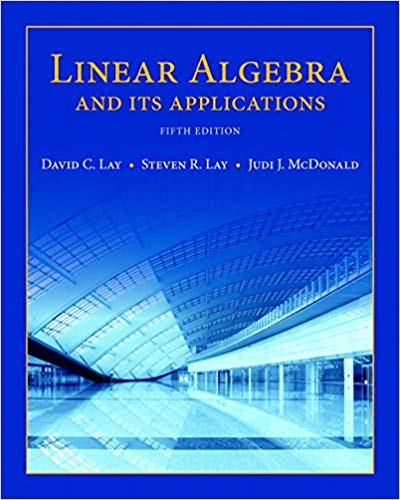
Linear Algebra and Its Applications, 5th Edition
Authors: David C. Lay, Steven R. Lay, Judi J. McDonald
ISBN-13: 978-0321982384
We have solutions for your book!
See our solution for Question 22E from Chapter 5.3 from Lay's Linear Algebra and Its Applications, 5th Edition.
Problem 22E
Chapter:
Problem:
In Exercises 21 and 22, A, B, P, and D are n × n matrices. Mark each statement True or False. Justify each answer. (Study Theorems 5 and 6 and the examples in this section
Step-by-Step Solution
Given Information
A, B, P and D are $n \times n$ matrices. We are given with some statements that we have to find whether they are true or false.
Step-1: (a)
Statement: A is diagonalizable if A has $n$ eigenvectors.
The statement is False. By Theorem-5, an $n \times n$ matrix is diagonalizable if and only if it has $n$ linearly independent eigenvectors. In the statement, the term linearly independent is missing
False
Step-2: (b)
Statement: If A is diagonalizable, then A has $n$ distinct eigenvalues
The statement is False. Consider at counter example, \[\left[ {\begin{array}{*{20}{c}}1&3&3\\{ - 3}&{ - 5}&{ - 3}\\3&3&{ - 5}\end{array}} \right]\]The above matrix is diagonalizable, however, it has only two distinct eigenvalues.
False
Step-3: (c)
Statement: If AP = PD, with D diagonal, then the nonzero columns of P must be eigenvectors of A
The statement is True. From the diagonalizable theorem, if AP=PD then, $A = PD{P^ - }$ with D being the diagonal matrix, if and only if the columns of p are n linearly independent eigenvectors of the matrix A. Hence, the diagonal entries of D are eigenvalues of A that correspond, respectively to the eigenvectors in p.
True
Step-4: (d)
Statement: If A is invertible, then A is diagonalizable.
The statement is False. For an invertible matrix, the only condition is that the columns must be linearly independent. However, for diagonalizable matrix, it should have $n$ linearly independent vectors. They both do not follow same condition.
False
A, B, P and D are $n \times n$ matrices. We are given with some statements that we have to find whether they are true or false.
Step-1: (a)
Statement: A is diagonalizable if A has $n$ eigenvectors.
The statement is False. By Theorem-5, an $n \times n$ matrix is diagonalizable if and only if it has $n$ linearly independent eigenvectors. In the statement, the term linearly independent is missing
False
Step-2: (b)
Statement: If A is diagonalizable, then A has $n$ distinct eigenvalues
The statement is False. Consider at counter example, \[\left[ {\begin{array}{*{20}{c}}1&3&3\\{ - 3}&{ - 5}&{ - 3}\\3&3&{ - 5}\end{array}} \right]\]The above matrix is diagonalizable, however, it has only two distinct eigenvalues.
False
Step-3: (c)
Statement: If AP = PD, with D diagonal, then the nonzero columns of P must be eigenvectors of A
The statement is True. From the diagonalizable theorem, if AP=PD then, $A = PD{P^ - }$ with D being the diagonal matrix, if and only if the columns of p are n linearly independent eigenvectors of the matrix A. Hence, the diagonal entries of D are eigenvalues of A that correspond, respectively to the eigenvectors in p.
True
Step-4: (d)
Statement: If A is invertible, then A is diagonalizable.
The statement is False. For an invertible matrix, the only condition is that the columns must be linearly independent. However, for diagonalizable matrix, it should have $n$ linearly independent vectors. They both do not follow same condition.
False